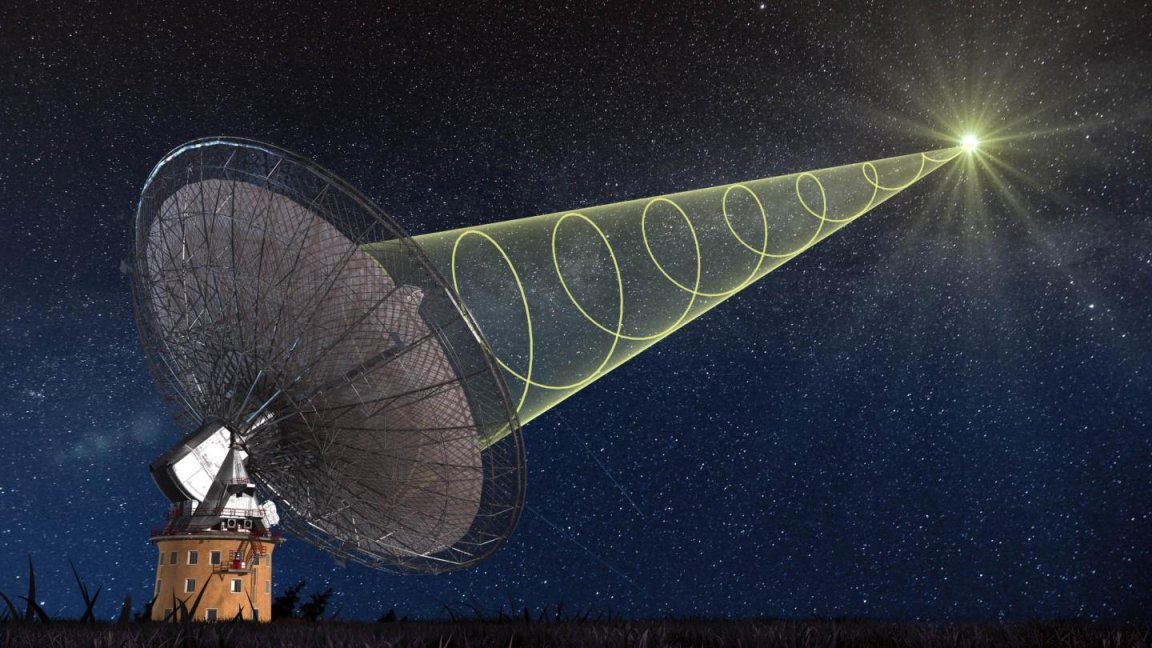
In a study published in a recent edition of the Monthly Notices of the Royal Astronomical Society, researchers have detected something called a fast radio burst (FRB): an unusual phenomenon that first surfaced in 2007, whereby a sharp, but brief, burst of radio waves is picked up by Earth-based radio telescopes.
When the first one happened, it was only learned of after-the-fact, when astronomers were looking through data collected by eastern Australia’s ‘Parkes Radio Telescope.’ In the years that followed, Parkes detected six nearly identical bursts, while another was found in Arecibo Telescope’s archival data.

Given their brevity (mere milliseconds after they appear, they are gone) and how it’s almost impossible to predict where one will happen, astronomers have had a difficult time pinpointing their location, that is, until recently.
The Mechanism of a FRB:
In order to see an RFB in real-time, a team of Australian researchers — led by Emily Petroff from Swinburne University of Technology in Australia — have devised a clever technique to pick up a fast radio burst as it happens (though, to be pedantic, nothing happens in real time. These burst actually happened hundreds of millions, maybe billions, of years ago. They just didn’t make it to Earth until now).
In their paper, they note that they believe the source of emission lurks around 5.5 billion light-years away: a notion that appears to be supported by other observatories that conducted follow-up observations in the minutes that followed. These observatories include NASA’s Swift — a multiwavelength observatory that specializes in gamma-ray bursts — and the Nordic Optical Telescope.
According to one researcher, Daniele Malesani from the Dark Cosmology Center in Denmark, the former yielded not one, but two x-ray sources in the field of view the FRB is believed to come from. With the latter observatory, “We observed in visible light and we could see that there were two quasars, that is to say, active black holes. They had nothing to do with the radio wave bursts, but just happen to be located in the same direction.”
Whittling The Options Down:
“We found out what it wasn’t. The burst could have hurled out as much energy in a few milliseconds as the Sun does in an entire day. But the fact that we did not see light in other wavelengths eliminates a number of astronomical phenomena that are associated with violent events such as gamma-ray bursts from exploding stars and supernovae, which were otherwise candidates for the burst,” notes Malesani.
Either way, the team did not come up empty-handed. Apparently, Parkes caught a glimpse of strange polarization in its light. Polarization, simply put, “is the direction in which electromagnetic waves oscillate and they can be linearly or circularly polarised. The signal from the radio wave burst was more than 20 percent circularly polarised and it suggests that there is a magnetic field in the vicinity.“
“The theories are now that the radio wave burst might be linked to a very compact type of object — such as neutron stars or black holes and the bursts could be connected to collisions or ‘star quakes.’ Now we know more about what we should be looking for,” says Daniele Malesani.
Last year, scientists confirmed that the signals that had been detected by Parkes Observatory are authentic. They verified these signals through information that was captured by the Arecibo Observatory in 2012.
The signals themselves are interesting. They are pretty much the opposite of pulsars. Instead of beaming out near constant emissions of light or radiation like pulsars, they shoot sporadic beams of pure radio waves out into space. These extremely powerful bursts can generate more energy in milliseconds than the Sun does in over 300,000 years*. What’s more, the dispersal patterns indicate that these signals come from billions upon billions of light-years away (some estimates put the objects causing the signals at some 3 billion light-years distant). This ultimately means that the signals are extra-galactic in origin (they do not come from a structure located in the Milky Way).

According to Heino Falcke (an astrophysicist from Radboud University Nijmegen) and Luciano Rezzolla (from the Max Planck Institute for Gravitational Physics), these brief blimps of pure radio waves are created in a highly unusual manner—when a neutron star dies and its magnetic field snaps “like a rubber band.” If correct, this “magnetic snap” would make these objects unlike anything we’ve ever seen before (and give them weird physics to boot).
They propose that blitzars begin when a supermassive neutron star fails to turn into black hole due to its rapid rotation and becomes a pulsar. In essence, a pulsar spins so fast that its centrifugal force prevents it from collapsing into a black hole. But of course, this speed is not static. After a few million years, once the pulsar’s strong magnetic field has sufficiently radiated energy away, the spin slows and it turns into a black hole.
Per Falcke and Rezzolla’s assertions, when this happens, the magnetic field sometime “snaps” as the source of the magnetic field (the pulsar) is now gone (turned into a black hole). It is this snapping that, they argue, causes the extreme radio signal that we are detecting. The scientists claim that other wavelength fall into the black hole that is created as the star dies, but radio waves (which are the longest wavelength) and able to escape.
They liken this event to the snapping of a rubber band. While this is an extremely intriguing possibility, it has yet to be peer-reviewed or confirmed.
[See the full article, “Unexplained Intergalactic Radio Bursts Confirmed At Arecibo” here]